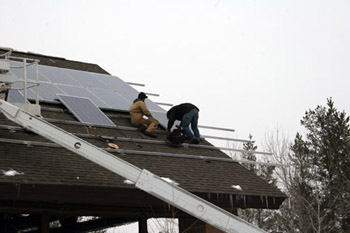The Northland Arboretum (the Arb) in Brainerd, Minnesota, has worked to educate and engage its visitors on important environmental issues for decades. This nonprofit organization provides nature trails that are available year-round for hiking, biking, snow-shoeing and skiing. The Arb also offers classes, workshops, and seminars that are held at the Arboretum’s Visitor Center. They can now add solar energy to their list of offerings, complete with engaging learning tools.
The Arb allows visitors to enjoy and learn about native plant and animal species in a number of different habitats, and now renewable energy. Over the past two years the Arb has made exciting new additions to the visitor’s center, including a solar PV array. system with a touch screen interface that merges the data from solar panels and energy cost data together. The result is an interactive program that is designed to educate the 26,000 visitors who come to the Arboretum annually and show them the value of renewable energy production. Arboretum Director Dale Braddy points out the impact a system like this can provide, “Our information is all real time,” he explained, “so people can see immediate savings.”
 The Arboretum reached out to CERTs to secure a seed grant to hire the technical assistance needed to design and program the interface. The Northland Arboretum is developing a comprehensive environmental education program (CEEP), of which the solar array and data interface are elements. When CEEP is completed it will enhance the Arboretum’s role as a demonstration site for environmental science, research, and education.
The Arboretum reached out to CERTs to secure a seed grant to hire the technical assistance needed to design and program the interface. The Northland Arboretum is developing a comprehensive environmental education program (CEEP), of which the solar array and data interface are elements. When CEEP is completed it will enhance the Arboretum’s role as a demonstration site for environmental science, research, and education.
Today, this interface displays data from the solar panels on the roof and data from the Energy Detective System. The design also incorporates the Arboretum’s website for the general public and Arboretum members to access, resulting in an interactive program designed to educate the visitors by showing the value of energy conservation. Anyone who is able to access the internet can visit the Arb’s solar array monitoring web page. There, you can look at how much the system is producing in real time, along with how much energy they system has used over the course of the last week, month, or lifetime.
Before the array could be added to the roof, the location of the modules on the Arb Visitor Center was determined by a solar site evaluation performed by Innovative Power Systems, who later installed the panels. The software used to monitor the panels is called “Enlighten” by Enphase Energy, which also supplied the microinverters that connect to individual PV modules needed to covert DC to AC.
The solar panels on the Arboretum have produced 14.4 MWh over the past year. The panels face west on the roof, allowing them to be visible to people who come to the Arb’s Visitor Center. The array’s prominent position makes the project more effective as a teaching tool. Any electricity that is generated by the Arb but not needed on site is sent into the local power grid to be used by the community. It is credited to the Arb by the power company.
Braddy’s advice to others for implementing a project like this is to lengthen the time it takes to complete it, since you will almost certainly run into a delay in some form or another.
As they stand, the use of the panels has still led to a total carbon offset of 9.96 tons per year, which is the equivalent of planting 255 additional trees on the Arb’s property! The Northland Arboretum’s combination of education and electricity generation make this project that will benefit the Arb and its visitors for years to come.
Project Snapshot:
- Central CERT Grant: $2,500
- Total Project Cost: $17,300
- Estimated Annual Carbon Emissions Reductions: 9.96 tons
- Estimated Energy Generation: 14.4 MWh/yr
About the Local Government Energy Action Series:
This year-long effort tells the stories of nearly 50 Minnesota municipalities, counties, and schools and the tangible results of their energy-saving efforts to inspire others to take their own actions.
Local Government Energy Action is brought to you by the Clean Energy Resource Teams (CERTs) in partnership with the Minnesota Department of Commerce, Division of Energy Resource


